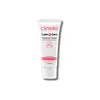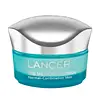What's inside
What's inside
 Key Ingredients
Key Ingredients

 Benefits
Benefits

 Concerns
Concerns

 Ingredients Side-by-side
Ingredients Side-by-side

Water
Skin ConditioningDicaprylyl Carbonate
EmollientCaprylic/Capric Triglyceride
MaskingPropylene Glycol
HumectantCetyl Alcohol
EmollientButyrospermum Parkii Butter
Skin ConditioningGlyceryl Stearate
EmollientPEG-100 Stearate
Pentylene Glycol
Skin ConditioningBisabolol
MaskingCarbomer
Emulsion StabilisingAlpha-Glucan Oligosaccharide
CleansingCaprylyl Glycol
EmollientChlorphenesin
AntimicrobialDipotassium Glycyrrhizate
HumectantHelianthus Annuus Seed Oil
EmollientOlea Europaea Fruit Oil
MaskingSimmondsia Chinensis Seed Oil
EmollientTetrasodium EDTA
Tocopheryl Acetate
AntioxidantPolymnia Sonchifolia Root Juice
Skin ConditioningDipropylene Glycol
HumectantGlyceryl Caprylate
EmollientMaltodextrin
AbsorbentSodium Hydroxide
BufferingSodium Hyaluronate
HumectantRuscus Aculeatus Root Extract
AstringentAloe Barbadensis Leaf Extract
EmollientGlycerin
HumectantLactobacillus
Skin ConditioningTocopherol
AntioxidantAcetyl Tetrapeptide-40
Skin ConditioningCentella Asiatica Extract
CleansingWater, Dicaprylyl Carbonate, Caprylic/Capric Triglyceride, Propylene Glycol, Cetyl Alcohol, Butyrospermum Parkii Butter, Glyceryl Stearate, PEG-100 Stearate, Pentylene Glycol, Bisabolol, Carbomer, Alpha-Glucan Oligosaccharide, Caprylyl Glycol, Chlorphenesin, Dipotassium Glycyrrhizate, Helianthus Annuus Seed Oil, Olea Europaea Fruit Oil, Simmondsia Chinensis Seed Oil, Tetrasodium EDTA, Tocopheryl Acetate, Polymnia Sonchifolia Root Juice, Dipropylene Glycol, Glyceryl Caprylate, Maltodextrin, Sodium Hydroxide, Sodium Hyaluronate, Ruscus Aculeatus Root Extract, Aloe Barbadensis Leaf Extract, Glycerin, Lactobacillus, Tocopherol, Acetyl Tetrapeptide-40, Centella Asiatica Extract
Water
Skin ConditioningCaprylic/Capric Triglyceride
MaskingGlycerin
HumectantC12-15 Alkyl Benzoate
AntimicrobialDimethicone
EmollientButyrospermum Parkii Butter
Skin ConditioningSqualane
EmollientCetyl Alcohol
EmollientGlyceryl Stearate
EmollientPEG-100 Stearate
Stearic Acid
CleansingDimethicone Crosspolymer
Emulsion StabilisingCetyl Phosphate
EmulsifyingVitis Vinifera Juice Extract
AntioxidantTropaeolum Majus Extract
AntimicrobialPersea Gratissima Oil
Skin ConditioningOlea Europaea Fruit Oil
MaskingHydrolyzed Rice Protein
Skin ConditioningHexapeptide-48 Hcl
Skin ConditioningDipotassium Glycyrrhizate
HumectantSodium Hyaluronate Crosspolymer
HumectantPhytosterols
Skin ConditioningRaspberry Seed Oil/Tocopheryl Succinate Aminopropanediol Esters
Skin ConditioningPolyglyceryl-4 Diisostearate/Polyhydroxystearate/Sebacate
EmulsifyingCarbomer
Emulsion StabilisingEthylhexyl Stearate
EmollientDisodium EDTA
Sodium Isostearate
CleansingAminomethyl Propanol
BufferingPropanediol
SolventCaprylyl Glycol
EmollientChlorphenesin
AntimicrobialEthylhexylglycerin
Skin ConditioningPhenoxyethanol
PreservativePentylene Glycol
Skin ConditioningParfum
MaskingLimonene
PerfumingWater, Caprylic/Capric Triglyceride, Glycerin, C12-15 Alkyl Benzoate, Dimethicone, Butyrospermum Parkii Butter, Squalane, Cetyl Alcohol, Glyceryl Stearate, PEG-100 Stearate, Stearic Acid, Dimethicone Crosspolymer, Cetyl Phosphate, Vitis Vinifera Juice Extract, Tropaeolum Majus Extract, Persea Gratissima Oil, Olea Europaea Fruit Oil, Hydrolyzed Rice Protein, Hexapeptide-48 Hcl, Dipotassium Glycyrrhizate, Sodium Hyaluronate Crosspolymer, Phytosterols, Raspberry Seed Oil/Tocopheryl Succinate Aminopropanediol Esters, Polyglyceryl-4 Diisostearate/Polyhydroxystearate/Sebacate, Carbomer, Ethylhexyl Stearate, Disodium EDTA, Sodium Isostearate, Aminomethyl Propanol, Propanediol, Caprylyl Glycol, Chlorphenesin, Ethylhexylglycerin, Phenoxyethanol, Pentylene Glycol, Parfum, Limonene
Ingredients Explained
These ingredients are found in both products.
Ingredients higher up in an ingredient list are typically present in a larger amount.
This ingredient is also known as shea butter. It is an effective skin hydrator and emollient.
Emollients help soothe and soften your skin. It does this by creating a protective film on your skin. This barrier helps trap moisture and keeps your skin hydrated. Emollients may be effective at treating dry or itchy skin.
Shea butter is rich in antioxidants. Antioxidants help fight free-radicals, or molecules that may harm the body. It is also full of fatty acids including stearic acid and linoleic acid. These acids help replenish the skin and keep skin moisturized.
While Shea Butter has an SPF rating of about 3-4, it is not a sunscreen replacement.
Shea butter may not be fungal acne safe. We recommend speaking with a professional if you have any concerns.
Learn more about Butyrospermum Parkii ButterThis ingredient is an emollient, solvent, and texture enhancer. It is considered a skin-softener by helping the skin prevent moisture loss.
It helps thicken a product's formula and makes it easier to spread by dissolving clumping compounds.
Caprylic Triglyceride is made by combining glycerin with coconut oil, forming a clear liquid.
While there is an assumption Caprylic Triglyceride can clog pores due to it being derived from coconut oil, there is no research supporting this.
Learn more about Caprylic/Capric TriglycerideCaprylyl Glycol is a humectant and emollient, meaning it attracts and preserves moisture.
It is a common ingredient in many products, especially those designed to hydrate skin. The primary benefits are retaining moisture, skin softening, and promoting a healthy skin barrier.
Though Caprylyl Glycol is an alcohol derived from fatty acids, it is not the kind that can dry out skin.
This ingredient is also used as a preservative to extend the life of products. It has slight antimicrobial properties.
Learn more about Caprylyl GlycolCarbomer is a polymer of acrylic acid. Its main role is to create a gel consistency.
A high amount of carbomer can cause pilling or balling up of products. Don't worry, most products contain 1% or less of carbomer.
Cetyl Alcohol is a fatty alcohol. Fatty Alcohols are most often used as an emollient or to thicken a product.
Its main roles are:
Though it has "alcohol" in the name, it is not related to denatured alcohol or ethyl alcohol.
The FDA allows products labeled "alcohol-free" to have fatty alcohols.
Learn more about Cetyl AlcoholChlorphenesin is a synthetic preservative. It helps protect a product against bacteria in order to extend shelf life. In most cases, Chlorphenesin is paired with other preservatives such as phenoxyethanol and caprylyl glycol.
Chlorphenesin is a biocide. This means it is able to help fight the microorganisms on our skin. It is also able to fight odor-releasing bacteria.
Chlorphenesin is soluble in both water and glycerin.
Studies show Chlorphenesin is easily absorbed by our skin. You should speak with a skincare professional if you have concerns about using Chlorphenesin.
Learn more about ChlorphenesinDipotassium Glycyrrhizate comes from licorice root.
Extracts of licorice have demonstrated to have antibacterial, anti‐inflammatory, antiviral, antioxidant properties.
One component, glabridin, has extra potent antioxidant and soothing properties. It has also been found to block pigmentation from UVB rays in guinea pigs.
Licorice Root also contains a flavonoid. Flavonoids are a natural substance from in plants. Flavonoids also have antioxidant properties.
Another component, glycyrrhizin, has been found to have anti-inflammatory and antimicrobial benefits. This may make licorice root extract effective at treating acne. However, more research is needed to support this.
Liquiritin is one of the flavone compounds found in licorice. It has been found to help lighten skin by preventing tyrosinase from reacting with tyrosine. When the two react, protein is converted to melanin. Melanin is the substance in your body that gives your features pigmentation.
Licorice root is native to Southern Europe and Asia. It has been used in traditional Chinese medicine to help with respiratory issues.
Learn more about Dipotassium GlycyrrhizateGlycerin is already naturally found in your skin. It helps moisturize and protect your skin.
A study from 2016 found glycerin to be more effective as a humectant than AHAs and hyaluronic acid.
As a humectant, it helps the skin stay hydrated by pulling moisture to your skin. The low molecular weight of glycerin allows it to pull moisture into the deeper layers of your skin.
Hydrated skin improves your skin barrier; Your skin barrier helps protect against irritants and bacteria.
Glycerin has also been found to have antimicrobial and antiviral properties. Due to these properties, glycerin is often used in wound and burn treatments.
In cosmetics, glycerin is usually derived from plants such as soybean or palm. However, it can also be sourced from animals, such as tallow or animal fat.
This ingredient is organic, colorless, odorless, and non-toxic.
Glycerin is the name for this ingredient in American English. British English uses Glycerol/Glycerine.
Learn more about GlycerinGlyceryl Stearate is a mix of glycerin and stearic acid.
It is used to stabilize the mixing of water and oil ingredients. By preventing these ingredients from separating, it can help elongate shelf life. It can also help thicken the product's texture.
As an emollient, it helps soften skin and supports barrier-replenishing ingredients.
In cosmetics, Glyceryl Stearate is often made from vegetable oils or synthetically produced.
This ingredient may not be fungal-acne safe
Fun fact: The human body also creates Glyceryl Stearate naturally.
Learn more about Glyceryl StearateOlea Europaea Fruit Oil is the fixed oil obtained from the ripe fruit of the Olive. In other words - olive oil.
The primary contents of olive oil are glycerides of the fatty acids linoleic, oleic and palmitic.
Olive oil also contains antioxidants such as Vitamin E. Antioxidants may help reduce signs of aging by fighting unstable free-radical molecules. It also contains Vitamins A (retinol), D, and K.
The squalene in olive oil makes it a great emollient. Emollients help soothe and soften your skin by trapping moisture in. This makes olive oil a great skin moisturizer.
Studies show olive oil to have antibacterial and antifungal properties in low concentrations. Another study found olive oil irritated sensitive oily skin. We always recommend speaking with a professional about using this ingredient in your routine.
Due to the fatty acid content, this ingredient may not be fungal-acne safe.
Learn more about Olea Europaea Fruit OilPeg-100 Stearate is an emollient and emulsifier. As an emollient, it helps keep skin soft by trapping moisture in. On the other hand, emulsifiers help prevent oil and water from separating in a product.
PEGS are a hydrophilic polyether compound . There are 100 ethylene oxide monomers in Peg-100 Stearate. Peg-100 Stearate is polyethylene glycol ester of stearic acid.
Pentylene glycol is typically used within a product to thicken it. It also adds a smooth, soft, and moisturizing feel to the product. It is naturally found in plants such as sugar beets.
The hydrophilic trait of Pentylene Glycol makes it a humectant. As a humectant, Pentylene Glycol helps draw moisture from the air to your skin. This can help keep your skin hydrated.
This property also makes Pentylene Glycol a great texture enhancer. It can also help thicken or stabilize a product.
Pentylene Glycol also acts as a mild preservative and helps to keep a product microbe-free.
Some people may experience mild eye and skin irritation from Pentylene Glycol. We always recommend speaking with a professional about using this ingredient in your routine.
Pentylene Glycol has a low molecular weight and is part of the 1,2-glycol family.
Learn more about Pentylene GlycolWater. It's the most common cosmetic ingredient of all. You'll usually see it at the top of ingredient lists, meaning that it makes up the largest part of the product.
So why is it so popular? Water most often acts as a solvent - this means that it helps dissolve other ingredients into the formulation.
You'll also recognize water as that liquid we all need to stay alive. If you see this, drink a glass of water. Stay hydrated!
Learn more about Water